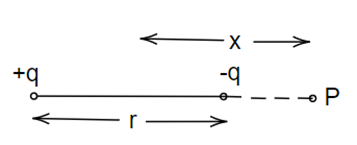
The distance between the two charges +q and −q of a dipole is r. The intensity at a point on the axial line at a distance x from the center of the dipole is proportional to
A. \[\dfrac{q}{{{x^2}}} \\ \]
B. \[\dfrac{{qr}}{{{x^2}}} \\ \]
C. \[\dfrac{q}{{{x^3}}} \\ \]
D. \[\dfrac{{qr}}{{{x^3}}}\]
Answer
217.8k+ views
Hint:Before we start addressing the problem, we need to know about the electric field intensity due to the dipole. When a unit positive charge placed at a point experiences a force, this force is defined as the electric field intensity. If the intensity is directed away from the charge, then it is due to the influence of a positive charge and if it is directed towards the charge then it is due to a negative charge.
Formula Used:
To find the magnitude of the intensity of the electric field, we have
\[E = \dfrac{1}{{4\pi {\varepsilon _0}}} \times \dfrac{{2P}}{{{x^3}}}\]
Where, P is the electric dipole of the dipole moment, x is the distance from the center of a dipole and \[{\varepsilon _0}\] is the permittivity of free space.
Complete step by step solution:

Image: Two charges of a dipole separated by a distance r.
Consider the two charges +q and −q of a dipole which is separated by a distance r. we need to find the intensity at a point on the axial line at a distance x from the center of the dipole. We know the formula to find the magnitude of the intensity of the electric field is,
\[E = \dfrac{1}{{4\pi {\varepsilon _0}}} \times \dfrac{{2P}}{{{x^3}}}\]
Here, P is the dipole moment, \[P = qr\], here q is the charge of a dipole and r is the distance between the two dipoles.
Substituting the value of P in above equation we get,
\[E = \dfrac{1}{{4\pi {\varepsilon _0}}} \times \dfrac{{2qr}}{{{x^3}}} \\ \]
\[ \therefore E \propto \dfrac{{qr}}{{{x^3}}}\]
Therefore, the intensity at a point on the axial line at a distance x from the center of the dipole is proportional to \[\dfrac{{qr}}{{{x^3}}}\].
Hence, option D is the correct answer.
Note: Suppose if we have two charges, one is positive and one is negative then, the electric dipole gives the direction of the flow of charges. That is, from negative charge toward positive charge.
Formula Used:
To find the magnitude of the intensity of the electric field, we have
\[E = \dfrac{1}{{4\pi {\varepsilon _0}}} \times \dfrac{{2P}}{{{x^3}}}\]
Where, P is the electric dipole of the dipole moment, x is the distance from the center of a dipole and \[{\varepsilon _0}\] is the permittivity of free space.
Complete step by step solution:

Image: Two charges of a dipole separated by a distance r.
Consider the two charges +q and −q of a dipole which is separated by a distance r. we need to find the intensity at a point on the axial line at a distance x from the center of the dipole. We know the formula to find the magnitude of the intensity of the electric field is,
\[E = \dfrac{1}{{4\pi {\varepsilon _0}}} \times \dfrac{{2P}}{{{x^3}}}\]
Here, P is the dipole moment, \[P = qr\], here q is the charge of a dipole and r is the distance between the two dipoles.
Substituting the value of P in above equation we get,
\[E = \dfrac{1}{{4\pi {\varepsilon _0}}} \times \dfrac{{2qr}}{{{x^3}}} \\ \]
\[ \therefore E \propto \dfrac{{qr}}{{{x^3}}}\]
Therefore, the intensity at a point on the axial line at a distance x from the center of the dipole is proportional to \[\dfrac{{qr}}{{{x^3}}}\].
Hence, option D is the correct answer.
Note: Suppose if we have two charges, one is positive and one is negative then, the electric dipole gives the direction of the flow of charges. That is, from negative charge toward positive charge.
Recently Updated Pages
Arithmetic, Geometric & Harmonic Progressions Explained

Cartesian Form of Vector Explained: Formula, Examples & Uses

Apparent Frequency Explained: Formula, Uses & Examples

Calorimetry: Definition, Principles & Calculations

Centrifugal Force Explained: Definition, Formula & Examples

Charge in a Magnetic Field: Definition, Formula & Examples

Trending doubts
JEE Main 2026: Application Form Open, Exam Dates, Syllabus, Eligibility & Question Papers

Derivation of Equation of Trajectory Explained for Students

Hybridisation in Chemistry – Concept, Types & Applications

Understanding the Angle of Deviation in a Prism

Understanding Collisions: Types and Examples for Students

How to Convert a Galvanometer into an Ammeter or Voltmeter

Other Pages
JEE Advanced Marks vs Ranks 2025: Understanding Category-wise Qualifying Marks and Previous Year Cut-offs

Understanding Atomic Structure for Beginners

Ideal and Non-Ideal Solutions Explained for Class 12 Chemistry

Degree of Dissociation: Meaning, Formula, Calculation & Uses

Understanding Electromagnetic Waves and Their Importance

Understanding the Electric Field of a Uniformly Charged Ring




